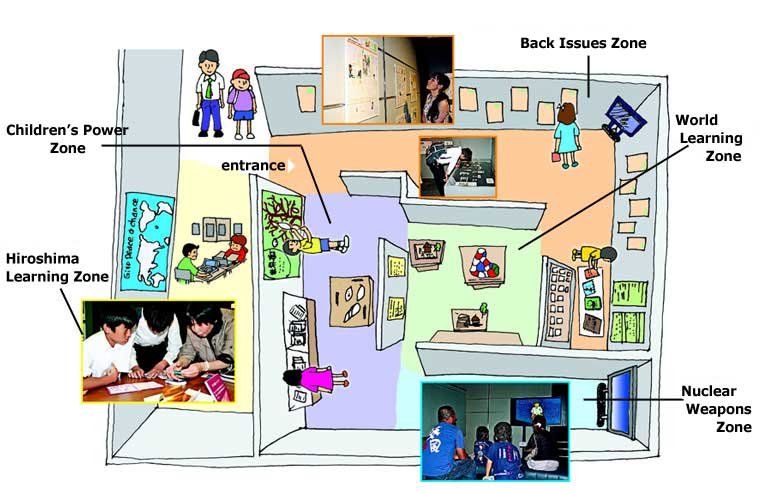The "Peace Seeds" exhibition!
An exhibition about "Peace Seeds" is being held at the Japan Newspaper Museum in the city of Yokohama from August 1 to September 23. The junior writers took part in the opening ceremony held on August 1. This issue contains a report on the exhibition, which has about 250 items on display, as well as interviews with visitors.

| Back Issues Zone |
| Click to see the Peace Seeds exhibition |
Near the entrance, all previous issues of Peace Seeds, from the 1st issue to the 50th issue, are displayed at their original size.
On a TV monitor, visitors can watch video clips of the junior writers in action, including an interview with Yohei Kono, Japan's Speaker of the House of Representatives at the time, and a workshop about peace stamps. The monitor also features a simultaneous broadcast that took place on August 6th from Hiroshima Peace Memorial Park and the exhibition venue.
A picture book called "Keys to Peace," which was produced by the junior writers for issue 24, can be read there, too.
Makoto Teshima, 38, a visitor from Hokkaido, accompanied by his wife, commented, "The exhibition made me feel that such problems as war and poverty can't be ignored just because we're okay."
| World Learning Zone |
This part of the exhibition features three-dimensional models by the Japanese International Cooperation Agency (JICA), an organization that provides support to developing countries. Visitors can learn things about Africa by touching the models and responding to quiz questions.
One model shows the life of an ethnic minority group with houses, wells, and roads. By moving a lever, ways to improve the community are revealed. In addition, there are panels that explain about the issues of trilateral trade and slavery as well as a quiz on the special products and animals of different African nations.
Yoshikazu Tachihara, the director of Administration Division of JICA Global Plaza, remarked, "We hope the visitors to this exhibition will think about our responsibility as citizens of developed countries and how we can help resolve problems in the world."
| Children's Power Zone |
Copies of letters to U.S. President Barack Obama, inviting him to visit Hiroshima, as well as letters to the City of Hiroshima from the participants of the G8 Speakers' Summit that took place in Hiroshima last year can be viewed in this part of the exhibition.
The "Children's Power Zone" also explains our project to invite Mr. Obama to Hiroshima, in which we called on readers to write letters to the president and had the English translations of these 335 letters delivered to the White House. Also introduced is the youth summit originally proposed by the junior writers, which is now moving forward to realization. We hope visitors feel the special power of children by viewing these displays.
Masashi Suzuki, 44, an elementary school teacher from Kanagawa Prefecture, said, "I think only the people of Hiroshima can convey certain things so I hope Mr. Obama will visit there."
Near the exit we created a "World Tree" to which visitors can add their messages of peace on leaf-shaped paper. By the evening of the opening day, about 20 messages had already been posted on the tree. Some of the messages express what the writers feel they can do for peace.
| Nuclear Weapons Zone |
In this part of the exhibition, visitors can see panels with some of the articles from the Peace Seeds column "Q&A about Hiroshima" and watch an animated film about the atomic bombing called "Shin's Tricycle."
| Hiroshima Learning Zone |
Outside the exhibition room is a space to learn more about Hiroshima. There are panels which share the story of Sadako Sasaki, a girl from Hiroshima who died of leukemia at the age of 12, a lingering result of the radiation released by the atomic bomb, and the movement after her death that led to the creation of the Children's Peace Monument in Hiroshima Peace Memorial Park. Eight computers are also available to access information about Hiroshima
On these computers visitors can try the "Quiz on Hiroshima and the Atomic Bomb," originally created by the junior writers for issue 33. In the newspaper, all 20 questions appeared together, but for the computer version the questions are divided into two levels, easier and harder, and they can be answered one by one, like a game. Tamami Obokata, 31, tried the quiz and said, "I realized that I don't know a lot about Hiroshima."
There is also an area where paper cranes can be folded and then attached to a large world map on the wall. The map reflects our wish that peace will spread throughout the world. Information pamphlets about 20 organizations working in the field of international cooperation are also available.
Shiori Kusuo, 16, Seira Furukawa, 16, Shotaro Takata, 15, and Reika Konno, 15 (photos) contributed to this article.